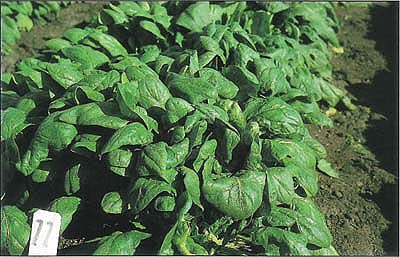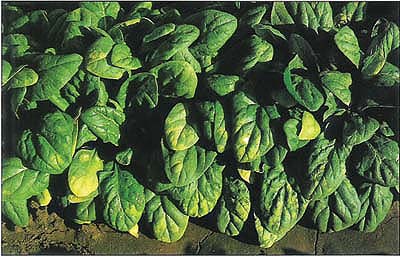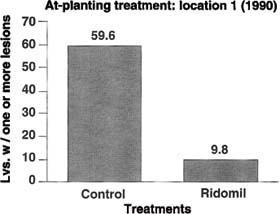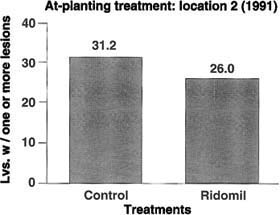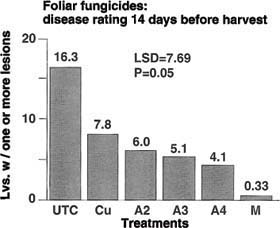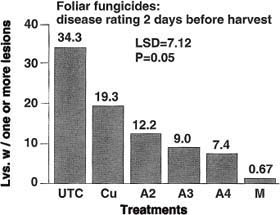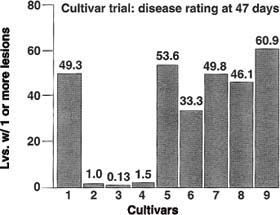All Issues
Resistant cultivars, fungicides combat downy mildew of spinach
Publication Information
California Agriculture 46(2):29-30.
Published March 01, 1992
PDF | Citation | Permissions
Abstract
The recent outbreak of spinach downy mildew, caused by a new race of the pathogen, left California growers without resistant cultivars and with few chemical controls. However, two fungicides have proved effective against the pathogen and two new resistant cultivars are now commercially available on a limited basis.
Full text
In late 1989, severe epidemics of downy mildew were observed in spinach plantings in coastal California. Most of the cultivars planted at that time were resistant to the three known races of Peronospora effusa. A new race, race 4, of the pathogen caused this outbreak of downy mildew (see California Agriculture, November-December 1990). Since the initial observations of this disease development in 1989, race 4 downy mildew has spread throughout the California spinach growing areas in both coastal and inland counties. Race 4 has also occurred in isolated regions in Texas. All commercial cultivars are susceptible to race 4, and the spinach industry experienced significant economic losses in 1989 and 1990. Few effective fungicides were available for use against this disease.
Like most agricultural host-pathogen relationships, spinach and P. effusa have both undergone many changes over the years. Up until the early 1950s, what is now designated as race 1 downy mildew plagued spinach crops. Researchers at that time developed a new spinach cultivar, ‘Califlay’, that was resistant to this pathogen. However, in 1958 race 2 appeared in California, rendering ‘Califlay’ and related cultivars susceptible once again. Researchers and plant breeders countered with ‘Early Hybrid 424’ and other cultivars; these were resistant to both races 1 and 2. These resistant spinach cultivars held up for almost 20 years until race 3 was reported in California in 1978. Shortly afterwards, breeders introduced ‘Polka’, ‘Shasta’, ‘St. Helens’ and other cultivars that were resistant to all three races and which are still widely used.
From this history, it is clear that short-term control options, such as fungicides, are required to help suppress disease levels until new resistant cultivars become available on a wide commercial basis. The purpose of our study was to evaluate the efficacy of fungicides against spinach downy mildew and to evaluate new, potentially resistant cultivars in the field.
Methods
Fungicides. We conducted fungicide trials during peak downy mildew months (December through April) in Monterey County in 1990 and 1991. Experiments consisted of separate at-planting and foliar fungicide applications. We applied at-planting treatments to randomized complete blocks with five replications and 20-foot-by-20-inch plots. The two treatments consisted of the following: Ridomil 2E (0.5 gal/acre) applied to the soil as a single spray over the seed lines at planting, and an untreated control. The Ridomil was watered in with the first irrigation. At location 1 (1990), the susceptible cultivar CX5086 was planted in six seed lines per bed. Location 2 (1991) was planted in the same manner with the susceptible cultivar ‘Polka’. We applied no foliar fungicides to the plots for the duration of either trial.
For the foliar fungicide trials (1990), we treated randomized complete blocks with four replications and plots of 25 feet x 20 inches. Treatments consisted of the following: basic copper sulfate (4 Ibs/ac), maneb 80 (2 lb/ac), Aliette 80W (2, 3 and 4 lb/ac) and an untreated control. We used NuFilm-P (6 oz/ac) with the copper and maneb treatments. We applied the materials four times at 7- to 10-day intervals. The susceptible cultivar ‘Polka’ was planted in six seed lines per bed; no at-planting fungicides were applied to the trial area.
For all experiments, we evaluated disease levels by counting the number of leaves that had at least one downy mildew lesion in a 5-foot-by-l 0-inch area. Three such areas were rated for each plot, and the results were averaged.
Fig. 1. Disease control achieved by single at-planting application of Ridomil 2E. Fungicide was applied as a banded treatment over seed lines on February 24, 1990. Spinach cultivar was CX5086. Ridomil rate was 0.5 gal/ac. Evaluation was made at 38 days after treatment, or 17 days before harvest. Ridomil-treated plots were significantly less diseased than untreated plots (F=94.88; P<0.05).
Fig. 2. Disease control evaluation after 80 days of growth. Ridomil 2E was applied as a banded treatment over seedlines on Jan. 8, 1991. The spinach cultivar was ‘Polka’ and the Ridomil rate was 0.5 gal/ac. This evaluation was made 80 days after planting, or 4 days before harvest. Ridomil-treated and untreated plots did not differ significantly in disease severity (F=2.25; P>0.05).
Fig. 3. Disease control achieved after three applications of foliar fungicides (14 days before harvest). Cultivar “Polka” was planted Dec. 1, 1989. Applications were made at 7- to 10-day intervals beginning Jan. 29, 1990. Treatments were as follows: UTC = untreated control; Cu = basic copper sulfate, 4 lb/ac; A2 = Aliette, 2 lb/ ac; A3 = Aliette, 3 lb/ac; A4 = Aliette, 4 lb/ac; M = maneb, 2 lb/ac. NuFilm-P was added to the copper and maneb sprays.
Cultivars. We field-tested numerous commercially available and experimental lines of spinach in order to observe possible resistance or tolerance to race 4 of P. effusa. We planted test cultivars into randomized complete blocks with five replications and plot sizes of 10 feet x 20 inches. We evaluated the cultivars by counting the number of leaves that had at least one lesion in a 5-foot-by-10-inch area. Two such areas were evaluated for each plot and the results were averaged. Since race 4-suscep-tible ‘Polka’ is one of the most widely planted cultivars, we included it in each trial as a standard variety. We planted cultivars in both Monterey and San Benito counties, and did not apply any fungicides to these trials.
Results
Fungicides. In the at-planting experiments, Ridomil at 0.5 gal/ac greatly reduced the amount of downy mildew. At location 1 we evaluated the trial at 38 and 52 days after planting (17 and 3 days before harvest, respectively). At 38 days, Ridomil-treated plots averaged 9.8 diseased leaves per evaluation area whereas untreated areas averaged 59.6 diseased leaves (fig. 1). New mildew infections did not develop in either Ridomil or untreated plots by the second evaluation period.
However, Ridomil will not persist long enough to provide acceptable disease control if the spinach cropping period is lengthy and the pathogen is active. At location 2 (fig. 2), we evaluated disease levels at 80 days after planting (4 days before harvest). Untreated plots averaged 31.2 diseased leaves per area. Ridomil-treated areas averaged 26.0 diseased leaves and did not differ significantly from untreated plots.
We evaluated foliar treatments at 14 days (fig. 3) and 2 days (fig. 4) before harvest. Consistently, maneb was the best treatment against downy mildew, keeping the disease at low levels. Aliette was the second best fungicide for control of downy mildew, but it was much less effective than maneb. There was a significant trend regarding Aliette rates; disease levels decreased as Aliette rates were increased from 2 to 4 lb/ac. Basic copper sulfate was least effective in controlling the disease. At this location downy mildew continued to develop after the 14-day evaluation; differences between the treatments became more evident just before harvest (fig. 4).
Cultivars. In the cultivar trial at San Benito County, all the surrounding commercial spinach fields, which were grown without synthetic fungicides, had severe downy mildew disease. We evaluated the cultivars 47 days after planting (fig. 5). ‘Bossanova’ (1 diseased leaf per area), ‘Bolero’ (0.13 diseased leaf), and RS1250 (1.5 diseased leaf) had very low levels of disease compared to the ‘Polka’ standard (49.3 diseased leaves). Cultivar DMC 6 (33.3 diseased leaves) also had significantly less disease than ‘Polka’, but was much more infected than ‘Bossanova’, ‘Bolero’ and RS1250. All other cultivars in this trial had downy mildew counts that were comparable to or higher than ‘Polka’.
Of the resistant cultivars, ‘Bossanova’ and ‘Bolero’ are commercially available on a limited basis. RS1250 and DMC 6 are still experimental.
Discussion
Fungicides. Maneb is an effective fungicide against the spinach downy mildew pathogen. However, over the past several years, concern has increased about possible health risks associated with ethylene bisdithiocarbamate fungicides (EBDCs), such as maneb. The EBDCs have a break-down product, ethylene thiourea (ETU), which scientists have implicated in tumor development in test animals. Concerns about ETU residues on produce have caused chemical companies to withdraw maneb registrations for many crops. Apparently, when maneb inventories become depleted, this fungicide will no longer be available for use on spinach. Because of the demonstrated efficacy of Aliette, the California Department of Food and Agriculture granted a Section 18 Emergency Registration for the use of this fungicide on spinach.
Fig. 4. Disease evaluation 2 days before harvest. The location is the same as in fig. 3. Four applications were made to the crop. Treatments were as follows: UTC = untreated control; Cu = basic copper sulfate, 4lb/ac; A2 = Aliette, 2 lb/ac; A3 = Aliette, 3 lb/ac; A4 = Aliette, 4 lb/ac; M = maneb, 2 lb/ac. NuFilm-P was added to the copper and maneb sprays. As we increased the Aliette rate, disease severity decreased significantly (y = 34.2 - 14.81X + 2.05X2; R2 = 0.998).
Fig. 5. Cultivars planted in San Benito County. No fungicides were applied during the trial. Evaluation was made 47 days after planting. Cultivars were as follows: (1) ‘Polka’, (2) Bossanova', (3) ‘Bolero’, (4) RS 1250, (5) DMC 5, (6) DMC 6, (7) Triplet', (8) Triathlon', (9) Triade'. LSD = 11.79. P = 0.05.
This situation illustrates the difficulties involved with the changing agrichemical picture today. With the loss of an extremely effective material such as maneb, the industry must adopt the use of a less effective and more costly fungicide such as Aliette. Our observations of commercial plantings indicate that, for the most part, Aliette keeps spinach downy mildew at low levels. However, with severe inoculum pressure and favorable environmental conditions, this fungicide may not always keep the disease under acceptable levels.
The at-planting use of Ridomil is an effective, though short-lived, treatment. This material may protect short-season spinach up until harvest. However, the longer season crops grown in the winter or those grown for processing will be unprotected if Ridomil is used alone. Currently, we advise growers to include Ridomil at planting when possible, and then to follow with foliar applications of maneb, if available, or Aliette. Plant-back restrictions for Ridomil will prohibit use in all situations. Consult product labels and your local agricultural commissioner's office for information on all of these fungicides.
Cultivars. Resistant spinach cultivars that have suitable horticultural characteristics are clearly the preferred means of managing downy mildew disease. Our trials indicate that resistant cultivars now exist. ‘Bossanova’, ‘Bolero’ and RSI 250 show good resistance to the disease. Since these are newly developed lines and have only been tested and proved this year, the seed companies have just started to produce them on a commercial scale. Presumably, these varieties and others will soon be widely available to the spinach industry. Such cultivars should be relatively free of downy mildew until the next race of P. effusa develops.



